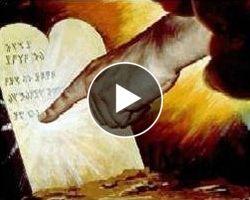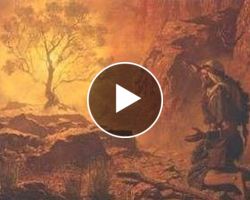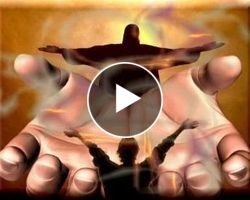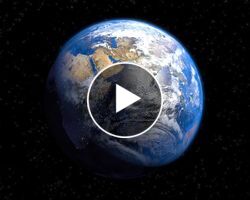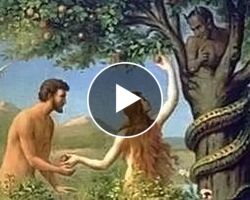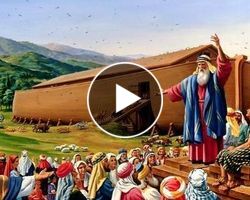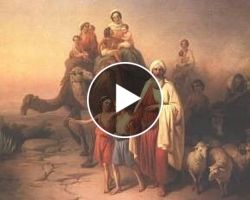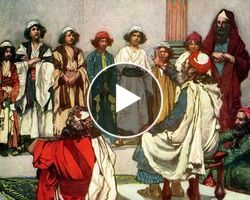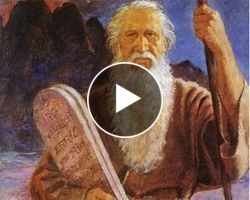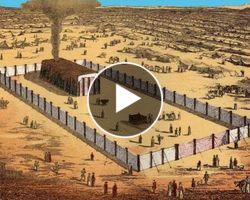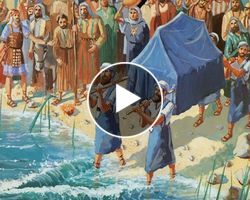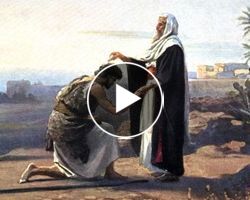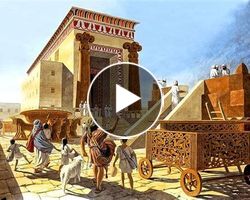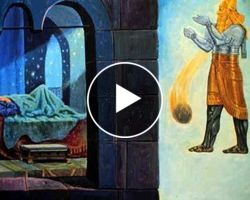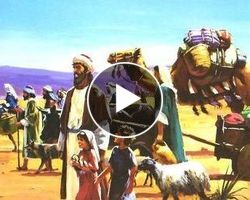Salvation History from Creation to the Coming of the Messiah
 Click on the lesson title to open the presentation. After the presentation opens, click anywhere to move to the next animation. Or click on the arrows << >> to navigate between slides.
Click on the lesson title to open the presentation. After the presentation opens, click anywhere to move to the next animation. Or click on the arrows << >> to navigate between slides.
Click on the image to open the video (if available).
You may also view and download a PDF summary handout of each lesson.
What is the meaning of life? Why search for truth? We consider the importance of seeking truth, popular worldviews, the human person as body and spirit, the spiritual world, the problems of evil and death, man’s longing for “more” – and the ultimate question: is there a God "out there" who really cares for us? [no handout]
A summary of God’s plan of salvation for mankind: God created us out of love. But our sin separates us from Him, and we cannot repair this break on our own. Jesus the Messiah has come to reconcile us with God and give us eternal life. He has established the Catholic Church through which he shares with us the way, the truth and the life. God calls us to repent, to choose to follow Jesus, and to join ourselves to his Body, the Church.
An overview of salvation history and summary of the entire course. God created the world and made a covenant with man, the crown of creation. But tempted by the devil, man sinned and lost God’s life. God gradually restored man to himself through his covenants with Noah, Abraham, Moses, David, and Jesus, who redeemed the human race in his Paschal Mystery. Jesus appointed his apostles to continue his work through the Church, until he returns at the end of history.
This is the first regular lesson of the course. It covers (a) how we can know with certainty, through human reason, that God exists, by looking at the physical world and at the human person; (b) some attributes of God that we can know through human reason: He is self-existent, infinite, one, eternal, spirit, immanent, transcendent, intelligent and good, all-knowing and all-powerful.
We can know God through human reason, but only in a limited way. Yet if God exists and is personal, He may well want to speak to us. But how? Through nature, private revelation, prayer, organized religion? Authentic divine revelation should agree with what we have learnt about God through reason (lesson 3). God has revealed himself progressively, in words and deeds, to the people of Israel, leading up to the fullness of his revelation in Jesus the Messiah. Divine revelation is God’s “map of life” for us.
Given that God speaks to us through His revelation, what does He tell us about Himself? God reveals Himself as Creator of the world and loving Father, who calls Himself “I AM.” He is holy, merciful, loving and true, and He provides for our every need. Includes a biblical narrative on God’s providence and the mystery of evil.
How shall we speak to our Father? Prayer is our response to God’s revelation. God has spoken to us; He also wishes that we speak to Him from our hearts. Every person is called to a loving relationship with God through prayer. Presents a historical overview of prayer in salvation history and Jesus’ teachings on prayer. Describes forms of prayer, sources of prayer, expressions of prayer, and obstacles to effective prayer.
This lesson begins the study of salvation history. God created the world “out of nothing” in wisdom and love, to show forth His glory and share His truth, goodness and beauty with His creation. He created an invisible (angelic) world and a visible (earthly) world. Man is the crown of creation. The Sabbath is the sign of the covenant between God and man. The world is a macro-temple; Eden is a sanctuary, and Adam is high priest of humanity.
God created man in His own image and likeness, as the crown of creation. God created man as body and soul, male and female, and He calls them to love. Man and woman are to become “one flesh” and be fruitful and multiply. By nature, man is God’s creature and servant; by grace, man is God’s beloved son, called to partake in God’s own life of love. Adam and Eve were created in a state of original holiness and justice, in perfect harmony with creation and free from suffering and death.
Tempted by the devil and wanting to be “like God, knowing good and evil,” Adam and Eve disobeyed God and sinned. As a consequence, their relationship with God was broken. They lost the grace of original holiness and justice and became afraid of God. The harmony between them and all of creation was destroyed. Suffering and death entered the world, and they were cast out of paradise. Adam and Eve wounded human nature and transmitted it to all of humanity in a fallen state, deprived of God’s eternal life - weak, subject to ignorance and inclined to sin.
God did not abandon man after the fall but promised him a future redemption (Gen 3:15). But humanity became so corrupt that God decided to destroy the world by means of a flood, preserving only Noah and his family in the ark. After the flood, God made a covenant with Noah, promising to never again wipe out the human race with a flood. He also gave seven basic commandments to Noah and to the new human family that would spring from him. The flood was a "decreation" of the world, and a “new creation” that prefigured the "new creation" of baptism.
God made a covenant with Abraham after calling him to leave his country and settle in the land of Canaan. God promised to make of Abraham a great nation, to make his name great, and to bless through him all families of the earth. These three promises were later fulfilled through the Mosaic, Davidic and New covenants. Abraham’s obedience and willingness to sacrifice his son Isaac reversed Adam’s disobedience and prefigured Jesus’ sacrifice of the New Covenant.
The second half of the book of Genesis focuses on the life of the patriarch Jacob. Starting off as a cunning trickster, Jacob undergoes a profound transformation during his 20-year exile in Haran. In that time, Jacob’s sons are born; they will become the fathers of the twelve tribes of Israel. When they turn against their brother Joseph and he ends up in Egypt, God raises him up and makes him a source of blessing and salvation not only to his family, but also to all neighboring countries. This dramatic story of Joseph and his brothers is a type of the future relationship between Jesus and his Jewish brothers.
Through Moses, God fulfilled his first promise to Abraham: to make his descendants a great nation. The children of Israel became enslaved in Egypt. God raised Moses to deliver them, inflicting ten plagues upon the Egyptians, which culminated with the Passover. God led the Israelites across the Red Sea and gave them the Torah at Mount Sinai, where He adopted them as His own people. God established the Tabernacle as the sacred place where he would meet His people. By worshiping the golden calf the Israelites broke the covenant, but God renewed it thanks to Moses’ mediation.
The book of Leviticus describes the laws concerning sacrifices, the consecration of priests, moral laws, purity and holiness, etc. In the book of Numbers, the Israelites set out towards Canaan; but because of their unbelief they were condemned to wander in the desert for 40 years. The book of Deuteronomy is the “second law,” Israel’s covenant rule which includes legal concessions, ritual stipulations, blessings and curses. God promised to raise up another prophet like Moses, and around the year 1400 B.C. He finally led His people to the border of the Promised Land.
In the book of Joshua, the Israelites cross the Jordan and conquer the land of Canaan. Under the leadership of Joshua, they conquer Jericho, then wage successful campaigns in the center, south, and north of Canaan. They conquer much – but not all – of the promised land, dividing it among the twelve tribes. In contrast, the period of the Judges is a time of decline and chaos: the Israelites enter a cycle of sin, oppression, repentance, salvation, and return to sin. God raises up judges who deliver the people from their oppressors; but while the first judges are successful, later judges increasingly fail in their role as leaders, so that "every man did what was right in his own eyes."
Samuel was the last judge: he anointed Saul to become the first king of Israel. But God rejected him because of his disobedience, and he was killed in battle. God raised David to become the next king of Israel. Through David, God fulfilled his second promise to Abraham - to make his name great. David conquered Jerusalem and brought the Ark of the Covenant into the city. God promised to establish an everlasting kingdom with the son of David, thereby transforming the national family of Israel into an imperial family and dynastic kingdom over other states and nations.
David's son Solomon built the Jerusalem Temple, a house of prayer for all nations. But Solomon later fell into sin and idolatry and the kingdom began to decline. After King Solomon’s death, the kingdom was divided into Judah (south) and Israel (north). The prophets were God’s voice, warning His people of judgment but also offering messianic hope and the promise of a “new Son of David.” All kings of Israel were evil, and the Assyrians conquered the northern kingdom in 722 B.C. Most kings of Judah were also sinful, and the Babylonians destroyed Jerusalem and deported the population in 586 B.C.
The dream of Babylonian king Nebuchadnezzar and other visions foresaw four great kingdoms (Babylon, Medo-Persia, Greece, and Rome), the last of which would be overtaken by the kingdom of God, which would rule over the whole earth. The Medo-Persians conquered Babylon in 539 B.C. Daniel has a vision of the heavenly “Son of Man” who will rule over all nations. The “70 weeks” of chapter 9 predict that the Messiah will appear near 32 A.D. and will be “cut off.” Daniel sees a vision of the final judgment and end of days.
In the Persian period, the Jews returned to Judah and rebuilt the temple. Nehemiah rebuilt the walls of the city, and the people renewed the covenant with God, but the Davidic kingdom was not restored. Alexander the Great conquered the Persian Empire in 333 B.C. After his death, Judea was controlled first by the Ptolemies, then by the Seleucids. Antiochus Epiphanes oppressed the Jews, leading to the Maccabean revolt and the Hasmonean dynasty. The development of second Temple Judaism: Pharisees and Sadducees. Rome conquers Judea and Herod becomes king.
In the Second Temple period there were high messianic expectations among the Jews. They hoped that God would restore the Davidic kingdom through the coming messiah. The prophets foretold that the messiah would be of the tribe of Judah, a prophet like Moses, son of David, and son of God, and born of a virgin in Bethlehem. He would perform miracles, be a light to the gentiles, and would be rejected by his people, “pierced” and sacrificed for our sins. This messiah would come before the destruction of the temple.
Jesus of Nazareth is the Messiah of Israel foretold by the prophets. The Son of God became man in order to save us, to show us God’s love, to be our model of holiness, and to make us partakers of the divine nature. This lesson looks at Jesus’ early years, from the Annunciation to Mary, Jesus’ miraculous birth in Bethlehem, his childhood and humble, hidden life in Nazareth, up to his baptism and temptation in the desert.
A brief overview of Jesus’ life, words and deeds, from the proclamation of the Kingdom, the Sermon on the Mount, healings and signs of the Kingdom, the parables of the Kingdom, up to the triumphal entry into Jerusalem on Palm Sunday. Draws material from all four gospels.
The central event of salvation history is the suffering, death, resurrection and ascension of Jesus, the Messiah of Israel. At the Last Supper, Jesus established a New Covenant with Israel and instituted the Eucharist. Betrayed by Judas and abandoned by all, he was condemned to death by crucifixion. His death is the paschal sacrifice of the New Covenant. On the third day he was raised from the dead. After appearing to his disciples for 40 days, he ascended to heaven and returned to God the Father.
This lesson examines Jesus’ claims and his identity according to the New Testament: The NT authors present Jesus as true man, messiah of Israel, the new Adam who reversed the first Adam’s disobedience, the new Son of Abraham and sacrificed lamb which the Lord provided, the new Moses who leads His people on a “New Exodus”, the new Son of David and king, the “Son of Man” spoken by Daniel, the Son of God, Lord and God.
This lesson examines Jesus' identity claims and considers whether they are credible. Evidence for the historical existence of Jesus. Can Jesus really be considered to be merely a good and wise man? Examination of Jesus’ claims to divinity. The reliability of the New Testament documents. Jesus: liar, lunatic, or Lord? Critical examination of the resurrection: fact or fiction?
Jesus claimed to be divine, yet distinct from God the Father – while affirming Jewish belief in the one God of Israel. How is this possible? The plurality of God in the OT and in Jewish sources. The “Word of God” and “angel of the Lord.” The angel Metatron, a “Son of God”? The divinity of the Messiah in the OT. God’s Spirit. The Trinity in the NT: one God, three persons. The second person: God’s knowledge, idea, word, Son. The third person: God’s spirit, God’s love. Introduction to the work of the Trinity, which will be expanded upon for the rest of the course.
Now that we have seen that God is a unity of three persons, we return and examine the work of the second person: Jesus’ Incarnation and Redemption. The Messiah’s redemptive death reconciles us to God. The four models of the atonement: The marketplace, the battlefield, the courtroom, and the temple.
We now look at the third person of the Trinity: the Holy Spirit - helper, consoler, Lord and giver of life. The hidden work of the Holy Spirit from creation to the coming of the Messiah. The Holy Spirit’s special relationship with Mary, mother of Jesus. Jesus lived in the fullness of the Holy Spirit, and He promised to send the Spirit to his disciples after He would leave them. The Holy Spirit was outpoured on the Church at Pentecost – God’s sanctifying love poured out into our hearts. The work of the Holy Spirit in the Church and how we can receive Him.
This lesson is an introduction to the Catholic Church. It provides a bridge between understanding the inner life of the Holy Trinity and sharing in this divine life as members of the Messiah’s body – the Church – the subject of the second half of the course. Jesus established His Church – one, holy, catholic and apostolic – to dispense the mysteries of the Holy Trinity to us through the offices of prophet, priest, and king (Scripture, Tradition, and the Magisterium). God shares His life with us through the Church’s seven sacraments. In the Church we are united with the saints in heaven and on earth, and most especially with Mary our Jewish mother.
Jesus the Messiah will come again in glory at the end of history, and the kingdom of God will come in its fullness. Before His return there will be many wars, the gospel will be preached to all nations, there will be increased anti-Christian persecution and a great apostasy in the Church. False prophets will deceive many, leading to the rise of the anti-Christ. Jesus’ second coming is suspended until his recognition by all of Israel. The resurrection of the body and the last judgment will be followed by the creation of new heavens and a new earth and the return of the human race to the tree of life of paradise.
Go to: Introduction - Portal to Lessons - Part II: Living in the Kingdom
Purchase PowerPoint Presentations





